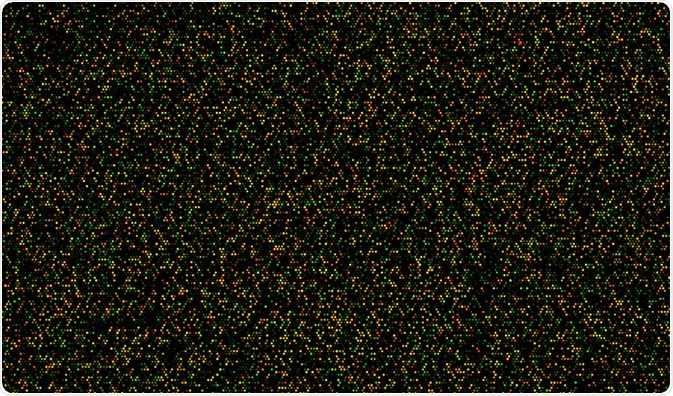Serial analysis of gene expression (SAGE) uses mRNA from a sample to create complementary DNA (cDNA) fragments for amplification and sequencing using high-throughput sequencing technology.

Credit: Andre Nantel/Shutterstock.com
SAGE is based on tags which can identify the original transcript, and rapid sequencing of tags linked together. The procedure essentially simplifies sequencing by linking the cDNA segments together in a long chain.
The resulting analysis gives a snapshot of the transcriptome of the sample, including the identity and abundance of each mRNA.
Microarray technology was developed in the 1970s. It uses labeled nucleic acids to measure expression of nucleic acid molecules bound to a solid support.
The microarray is assembled by spotting cDNA samples onto a solid substrate such as a glass microscope slide. Spots are 80 to 150 mm in diameter and placed at 100 nm intervals. Commercial arrays typically have 10,000 to 20,000 spots, and can contain as many as 80,000.
Comparisons between SAGE and cDNA microarrays
A cDNA microarray provides rapid screening for a very large number of samples, but does not detect unknown genes. SAGE detects unknown transcripts and can thus be used in organisms whose genomes are uncharacterized, but can’t process as many samples at once.
This difference represents a major limitation for microarray studies, even for organisms with completely sequenced genomes. That’s because genome annotation and prediction are not fully perfected.
Another difference between SAGE and cDNA microarrays is that SAGE data are very portable and directly comparable between experiments.
SAGE can determine absolute abundance of mRNAs and differences in expression levels between samples can be compared. In contrast, microarray data is specific to the format, so data sets cannot be easily compared between platforms.
Microarrays are also easier to use and more suitable for high-throughput experiments.
A number of studies have looked at SAGE and cDNA side-by-side
In 2006, a study published in the Journal of Plant Biology compared the output of two cDNA microarrays for gastric cancer tissues and cold stressed Arabidopsis with corresponding SAGE results. They found the results of the two methods correlated closely with each other.
The authors of the study suggest that a combinatorial approach could provide even more accurate gene expression analysis.
In another study from 2006, researchers compared microarray and SAGE technology for gene expression analysis in human glioblastoma to identify potential biomarkers of the disease.
They compared gene expression in glioblastoma with normal brain tissue from nine glioblastoma SAGE libraries and five normal brain SAGE libraries, then compared those results with published data from microarray-based hybridization experiments. The overlap was just 105 genes showing increased expression in glioblastoma between the two methods.
The authors concluded that all available studies should be used to select candidate marker genes, and only genes with very high expression in tumors and very low expression in normal tissue should be viewed as significant.
Sources
- Gene expression using microarrays
- Comparison between SAGE and cDNA microarray for quantitative accuracy in transcript profiling analyses
- Microarray, SAGE and their application to cardiovascular diseases
- Comparison of oligonucleotide-microarray and serial analysis of gene expression (SAGE) in transcript profiling analysis of megakaryocytes derived from CD34+ cells
- Serial analysis of gene expression
Further Reading
- All Microarray Content
- Types of Microarray
- Microarray Applications
- Protein and Peptide Microarray
- History of Microarrays
Last Updated: Aug 23, 2018

Written by
Dr. Catherine Shaffer
Catherine Shaffer is a freelance science and health writer from Michigan. She has written for a wide variety of trade and consumer publications on life sciences topics, particularly in the area of drug discovery and development. She holds a Ph.D. in Biological Chemistry and began her career as a laboratory researcher before transitioning to science writing. She also writes and publishes fiction, and in her free time enjoys yoga, biking, and taking care of her pets.
Source: Read Full Article